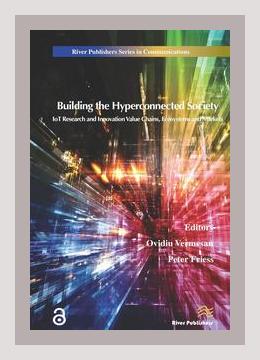Technology and Digital TransformationInternet of Things (IoT)
Building the Hyperconnected Society – IoT Research and Innovation Value Chains, Ecosystems and Markets
Summary
Building the Hyperconnected Society by Ovidiu Vermesan and Peter Friess is a comprehensive exploration of the Internet of Things (IoT) and its implications for society, technology, and business. The book covers a wide range of topics, from the foundational elements of IoT to specific industry applications and future trends. It emphasizes the importance of value chains, ecosystems, and markets in fostering IoT innovations and offers actionable insights for individuals and organizations looking to leverage IoT.
1. Introduction to IoT
Major Points:
- Definition of IoT: The Internet of Things is defined as a dynamic global network infrastructure with self-configuring capabilities based on standard and interoperable communication protocols where physical and virtual “things” have identities, physical attributes, and virtual personalities.
- Core Components: IoT consists of sensors, connectivity, data processing, and user interfaces.
- Value Proposition: The main value of IoT lies in smarter living and working environments through enhanced interconnectivity.
Actions:
- Understand IoT Basics: Familiarize yourself with the key components and definitions of IoT to build a solid foundation for further exploration.
- Invest in Training: Organizations should invest in training programs to ensure their workforce understands IoT fundamentals.
2. IoT Value Chains
Major Points:
- Value Creation: IoT enables value creation through the generation of new data, improved decision-making, and operational efficiencies.
- Value Chain Components: The IoT value chain includes device manufacturers, connectivity providers, data analytics firms, and end users.
- Ecosystem Interdependencies: Successful IoT implementations require collaboration across multiple stakeholders in the value chain.
Actions:
- Map the Value Chain: Identify and document the various elements and stakeholders within your IoT project’s value chain.
- Form Strategic Partnerships: Collaborate with other players in the ecosystem to leverage their expertise and resources.
3. Research and Innovation in IoT
Major Points:
- R&D Investments: Continuous research and development are crucial for advancing IoT technologies.
- Innovation Hubs and Clusters: Geographical clusters of innovation, such as Silicon Valley, play a significant role in IoT advancements.
- Public and Private Sector Roles: Both sectors must engage actively in R&D to drive IoT innovations.
Actions:
- Invest in R&D: Allocate resources for ongoing research and innovation efforts within your organization.
- Engage with Innovation Clusters: Participate in innovation hubs, conferences, and networks to stay updated with the latest IoT trends.
4. Standardization and Interoperability
Major Points:
- Standards Importance: Standards ensure interoperability, which is essential for the broad adoption of IoT.
- Key Organizations: Various global organizations, such as the IEEE and IETF, work on establishing IoT standards.
- Challenges: Achieving universal standards is challenging due to the diverse nature of IoT devices and applications.
Actions:
- Adopt Established Standards: Ensure that the IoT solutions you develop or use adhere to global standards.
- Participate in Standardization Efforts: Contribute to the development of new standards by engaging with standardization bodies.
5. IoT Ecosystems
Major Points:
- Ecosystem Components: IoT ecosystems comprise devices, platforms, networks, and applications.
- Platform-centric Ecosystems: Leading companies, such as Amazon and Google, have developed robust IoT ecosystems centered around their platforms.
- Innovation through Collaboration: Collaborative ecosystems enable greater innovation and faster development cycles.
Actions:
- Choose a Platform: Select and integrate with a leading IoT platform to benefit from existing ecosystems and market reach.
- Encourage Ecosystem Growth: Foster an ecosystem mentality within your organization by encouraging open collaboration and innovation.
6. Regulatory and Ethical Considerations
Major Points:
- Data Privacy: The IoT generates vast amounts of data, raising significant privacy concerns.
- Security Issues: Securing IoT devices and networks against cyber threats is paramount.
- Ethical Implications: Ethical considerations, such as data ownership and user consent, need careful thought.
Actions:
- Implement Robust Security Protocols: Prioritize security in all IoT deployments by adhering to best practices and standards.
- Focus on Privacy: Develop and enforce strict data privacy policies to protect user information.
7. IoT Market Dynamics
Major Points:
- Market Growth: The IoT market is experiencing rapid growth across various sectors, including healthcare, manufacturing, and smart cities.
- Business Models: New business models, such as IoT-as-a-Service, are emerging.
- Investment Opportunities: There are numerous investment opportunities within the growing IoT market.
Actions:
- Explore Business Models: Investigate and adopt new IoT business models that align with your organization’s goals.
- Invest Wisely: Identify and invest in high-potential IoT ventures for long-term growth.
8. Industry Applications
Major Points:
- Healthcare: IoT is revolutionizing healthcare through remote monitoring and smart medical devices.
- Manufacturing: The concept of Industry 4.0 leverages IoT for smarter manufacturing processes.
- Smart Cities: IoT is integral to developing smart cities with improved infrastructure and services.
Actions:
- Deploy Pilot Projects: Implement pilot IoT projects in relevant areas such as smart healthcare or manufacturing to test and refine capabilities.
- Scale Solutions: After successful pilot testing, scale IoT solutions to broader applications within your industry.
Conclusion
Building the Hyperconnected Society by Ovidiu Vermesan and Peter Friess provides a foundational understanding of the Internet of Things and its transformative potential. The book highlights the complex interplay of technology, value chains, ecosystems, and markets in creating a hyperconnected society. By following the actionable insights and examples provided, individuals and organizations can strategically position themselves to harness the myriad opportunities presented by IoT. Whether it’s through continuous learning, strategic collaborations, or innovative implementations, the key to success in the IoT landscape is a proactive and informed approach.
Technology and Digital TransformationInternet of Things (IoT)
